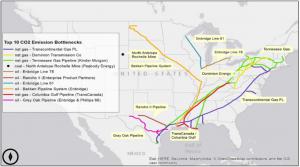New study: Many critical carbon emissions bottlenecks in the U.S. are not even American
Carbon emissions liability is a growing business risk. What companies carry the highest risk?
A comparison of the results for conventional point source pollution and bottleneck carbon emissions sources shows that oil and natural gas pipelines are far more important that simple point-source emissions calculations would indicate. It also shifts the emissions liability towards the east coast from the Midwest. Most surprisingly, the study found that 7 out of 8 oil pipelines in the U.S. responsible for facilitating the largest amount of carbon emissions are operated by Enbridge Inc., a multinational Canadian company.
Fossil fuels (coal, oil, and natural gas) emit carbon dioxide when burned, which is the greenhouse gas primarily responsible for global warming and climate change. Climate change causes numerous problems called ‘externalities’ by economists because they are external to the market. In the U.S. current law does not account for these costs so there is a growing call to use litigation to fix this market failure. The study by Alexis Pascaris in the Environmental & Energy Policy Program and Joshua Pearce, the Witte Professor of Engineering, investigated what companies are at most risk?
Pearce explained their past work found that “as climate science moves closer to being able to identify which emitters are responsible for climate costs and disasters, emissions liability is becoming a profound business risk for some companies.” Most work in this area focuses on who did the wrong and what are the costs. However, what is less clear is how climate related litigation could be strategically advanced if the goal of the litigation is to prevent future harm by shutting down current carbon emitters rather than simply compensating existing victims.
How should environmental organizations and others trying to protect people and the planet decide who are the most critical polluters to target for climate-related lawsuits? Pearce says, “Just like a bottleneck that limits the flow of water, what our emissions bottleneck theory does is identify what carbon emissions would be cut off if a facility was eliminated rather than only provide what emissions come directly from it as a point source. This study found that point source pollution in the context of carbon emissions can be quite misleading.”
For example, pipelines themselves create very little point source pollution, yet an enormous amount of effort has been focused on stopping the Keystone XL Pipeline because of the presumed emissions it enables. The study asked: Would the magnitude of the emissions enabled by a pipeline warrant the effort, or should lawsuits be focused elsewhere if minimizing climate change was the goal?
In order to answer this question quantitatively, the study presented an open and transparent methodology for prioritizing climate lawsuits based on an individual facility’s ability to act as a bottleneck for carbon emissions.
The results showed that the prominent carbon emission bottlenecks in the U.S. are for transportation of oil and natural gas. While the extraction of oil is geographically concentrated in both North Dakota and Texas, the pipeline network is extensive and transcends both interstate and national boundaries, further complicating legal issues. Overall, Enbridge is accountable for contributing 74% of the entire oil industry’s carbon emissions, making this company a likely prioritization for climate-related lawsuits. This may indicate that Enbridge is under particular risk for carbon emissions-related liability and thus warrant higher climate liability insurance premiums than other companies in the same sector. As a whole, fossil-fuel related companies identified in the study have increased risks due to legal liability, future regulations meant to curb climate destabilization and as targets for eco-terrorism. “All of these business risks would tend to increase insurance costs, but significant future work is needed to quantify what climate liability insurance costs should be for companies that enable major carbon emissions”, concludes Pearce.
Study: Alexis S. Pascaris and Joshua M. Pearce U.S. Greenhouse Gas Emissions Bottlenecks: Prioritization of Targets for Climate Liability. Energies 13(15), 2020, 3932; https://doi.org/10.3390/en13153932
MTU Open Sustainability Technology Lab Outreach
MOST
+1 906-487-1466
email us here
US Greenhouse gas emission bottlenecks - highest business risk for climate liability
Legal Disclaimer:
EIN Presswire provides this news content "as is" without warranty of any kind. We do not accept any responsibility or liability for the accuracy, content, images, videos, licenses, completeness, legality, or reliability of the information contained in this article. If you have any complaints or copyright issues related to this article, kindly contact the author above.

